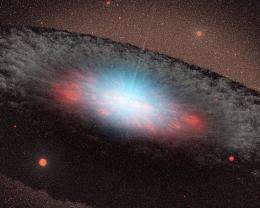September 8, 2011 report
Research team pinpoints location of elusive black hole using radio jets

(PhysOrg.com) -- A team of Japanese astrophysicists and space scientists have found a way to more precisely describe where in space a very large, but distant black hole lies. In their paper published in Nature, the team describes how they’ve used data from a large array of radio telescopes spread across the Pacific ocean to measure high energy emissions that are ejected from areas inside the galaxy M87 due to the actions of the massive black hole that lies somewhere near its center.
While it is commonly known that black holes generally suck up everything around them, there is one exception; jets of radio waves that are thought to form when material that is being sucked in spirals, forming a cone that ejects material as it spins. Sort of like a tornado that sucks up material then spits it out into the air. Only in this case, the jets are all perpendicular to the source. It’s because of these radio jet emissions that we here on Earth are able to find black holes. And though the process by which the jets form is still rather a mystery, scientists are getting closer, and that’s where this new research comes in.
To get a better picture of where the radio waves are actually emanating from inside of M87 relative to the black hole at its center, the team traced the radio jets (using data from the Very Long Baseline Array of radio satellites in the Pacific and complex mathematical models) to near their origin, which then allowed them to better estimate where the black hole actually resides. To their surprise they found that the core of the radio jet appears to be closer to the black hole itself (a fraction of a light year) than had been previously thought.
As with any advance in understanding the cosmos, the results of this latest research while providing new information on how galaxies and black holes work, they also whet the appetite for more. Newer and better radio telescopes still in the planning stages will hopefully give more detail about matter as it is being pulled into a black hole, giving new clues about what is emitted in the process.
More information: An origin of the radio jet in M87 at the location of the central black hole, Nature 477, 185–187 (08 September 2011) doi:10.1038/nature10387
Abstract
Powerful radio jets from active galactic nuclei are thought to be powered by the accretion of material onto the supermassive black hole (the ‘central engine’)1, 2. M87 is one of the closest examples of this phenomenon, and the structure of its jet has been probed on a scale of about 100 Schwarzschild radii (Rs, the radius of the event horizon)3. However, the location of the central black hole relative to the jet base (a bright compact radio ‘core’) remains elusive4, 5. Observations of other jets indicate that the central engines are located about 104–106Rs upstream from the radio core6, 7, 8, 9. Here we report radio observations of M87 at six frequencies that allow us to achieve a positional accuracy of about 20 microarcseconds. As the jet base becomes more transparent at higher frequencies, the multifrequency position measurements of the radio core enable us to determine the upstream end of the jet. The data reveal that the central engine of M87 is located within 14–23Rs of the radio core at 43 GHz. This implies that the site of material infall onto the black hole and the eventual origin of the jet reside in the bright compact region seen on the image at 43 GHz.
© 2011 PhysOrg.com





















